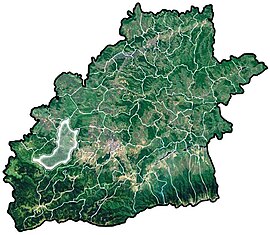Săliște
Town in Sibiu, Romania From Wikipedia, the free encyclopedia
Town in Sibiu, Romania From Wikipedia, the free encyclopedia
Săliște (German: Großendorf or Selischte; Hungarian: Szelistye) is a town in Sibiu County, in the centre of Romania, 21 km (13 mi) west of the county capital, Sibiu. Declared a town in 2003, it is the main locality in the Mărginimea Sibiului area.
Săliște | |
|---|---|
 The City Hall | |
 Location in Sibiu County | |
| Coordinates: 45°47′39″N 23°53′11″E | |
| Country | Romania |
| County | Sibiu |
| Government | |
| • Mayor (2020–2024) | Horațiu-Dumitru Răcuciu[1] (PNL) |
| Area | 226.78 km2 (87.56 sq mi) |
| Elevation | 542 m (1,778 ft) |
| Population (2021-12-01)[2] | 5,710 |
| • Density | 25/km2 (65/sq mi) |
| Time zone | EET/EEST (UTC+2/+3) |
| Postal code | 557225 |
| Area code | (+40) 02 69 |
| Vehicle reg. | SB |
| Website | www |
The town is situated at the edge of the Cindrel Mountains, on a series of river valleys which flow into the Cibin River, in the southwestern part of the Transylvanian Plateau. The main town of Săliște has a population of 2,830; it also administers nine villages:
| Year | Pop. | ±% |
|---|---|---|
| 2002 | 6,092 | — |
| 2011 | 5,040 | −17.3% |
| 2021 | 5,710 | +13.3% |
| Source: Census data | ||
Originally all the localities, except the village of Amnaș, were inhabited by Romanians. As of 2011, 95.7% of inhabitants were Romanians, 3.3% Roma, and 0.6% Germans.
Most Romanians are Orthodox and the Germans still living in Amnaș are Lutheran Evangelical. There are also some small Protestant Churches.
Traditionally the main occupation was shepherding and related activities. Today this occupies a smaller percentage of the workforce, but remains important alongside other agricultural activities. Light industry was developed in the recent period and there are some textile workshops. Commerce and services are also an important activity. The area around Aciliu and Amnaș is well suited for wines and around Mag and Săcel there are a series of artificial lakes for fish farming.
The film Blestemul pământului, blestemul iubirii was shot in the village of Fântânele in 1978–1979.[3]
The area was inhabited for a very long time, and on a hill between Sălişte and the nearby commune of Tilișca there are the ruins of an old Dacian citadel. The first document mentioning the town is from 1354 and refers, in Latin, to Magna Villa. Early names would be Nogfalu in Hungarian and Grossdorf in German. Later, in 1383 the village is known as Magna Villa Valachiealis (Big Village of the Vlachs), denoting its ethnically Romanian population. Still later, it was one of the villages in the Țara Amlașului (Omlás), a Transylvanian fiefdom granted by the kings of Hungary during the 14th and 15th centuries to the Wallachian rulers.
Around 1485 it was included in one of the seven seats of Saxondom.
In the late 18th century Săliște became an important village of the Romanian community and the most important cultural centre in the Mărginimea Sibiului area. In 1774 an important local revolt of the Romanian population took place; members of this community also participated in the revolution of 1848, the Transylvanian Memorandum movement, and almost every important event in the National awakening of the Romanians in Transylvania.
Some of the most notable personalities born in Săliște are:
Seamless Wikipedia browsing. On steroids.
Every time you click a link to Wikipedia, Wiktionary or Wikiquote in your browser's search results, it will show the modern Wikiwand interface.
Wikiwand extension is a five stars, simple, with minimum permission required to keep your browsing private, safe and transparent.